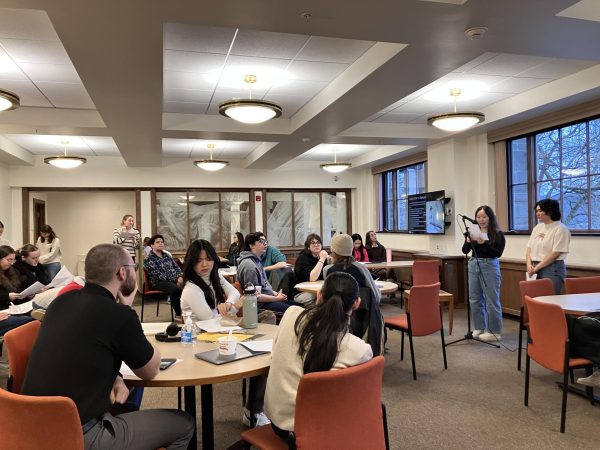Spring Awakening: A Children’s Tragedy

Everyone faces the transition from childhood to adulthood, but the characters in Spring Awaken-ing confront this change without any mentors, without any assis-tance and without any knowledge as to what they are supposed to do. Based on the 1982 German play by Frank Wedekind, which became a Broadway musical in 2006, the Colgate production of Spring Awakening, based on the play, was performed from March 28 to April 1 at Brehmer Theater.
Directed by Professor of Eng-lish and Director of the University Theater Adrian Giurgea, Spring Awakening: A Children’s Tragedy tells the tale of several teens struggling to cope with discovering sexuality, the pres-sures of life and their developing relation-ships. With the central characters encoun-tering issues such as parents’ expectations in school – the cause of character Moritz’s suicide – rape, expulsion, abortion and death, this play presents the borderline be-tween childhood and adulthood as a harsh reality, the end of imaginative fairytales.
These tragic events took place amidst a bleak backdrop; the set had smashed win-dows and the walls on each side were com-posed of drawers, reminiscent of coffins, which the actors used to transport them-selves on and off stage. While the children were portrayed by Colgate students, center-ing on the characters of Wendla, played by junior Danielle Solomon, Melchior, played by junior Christina Liu (one of several roles played by the opposite gender) and Moritz, played by senior Jimmy Andretta, the adults were represented by puppets or simply a voice. Suggesting exactly how ab-sent from these children’s lives their parents and other adults are, the performance had the narrator, senior Casey Macaulay, or As-sistant Professor of English in the University Theater April Sweeney, from offstage, voice the adults, or small puppets appeared in the place of actual adults.
Throughout the play, the way that elements of the plot were conveyed showed the audi-ence how these children were experiencing this period of their life. The blood we briefly see on Wendla after Melchior beats her leaves the audi-ence slightly confused as to what happens until we later hear she was raped in this scene. The changes in Wendla’s life are equally confusing to her, since her mother still insists that storks deliver babies. When Melchior’s parents argue over their son’s expulsion, the audience sees it as a puppet show, as if we, too, are chil-dren, watching these events unfold while trying to comprehend what it all means. Adults simply do not inform these children; instead, they either play no role in their lives at all or they serve as a terrifying au-thority figure. The administration that expels Melchior represents the threatening version of adults who make no attempt to understand the youth and, in the play, they appeared wearing elderly masks, donning black robes and having massive hands as they determined Melchior’s fate.
By the end of Spring Awaken-ing, characters have shown the difficulties of growing up, and some of them have not survived this growth. Melchior, devastat-ed that both his friend Moritz and the girl he possibly loved, Wendla, have died, visits the graveyard and contemplates his own suicide, but, after a conversation with the headless ghost of Moritz and a masked man, played by Professor of Music Joscelyn Godwin, he chooses to live. In this final moment, the play offers some hope that we can grow up and survive the process, if we endure it together.
In his introduction to the play, transla-tor Jonathan Franzen writes that the sub-title, A Children’s Tragedy, had an odd, irre-solvable, almost comic ring to it, suggesting that tragedy stoops to the childhood level, but instead we see that the fact that chil-dren face this tragedy makes it even worse. Perhaps, though, with the help of others – even if those others are headless ghosts – we can transition peacefully and successfully.
Contact Bridget Sheppard at






